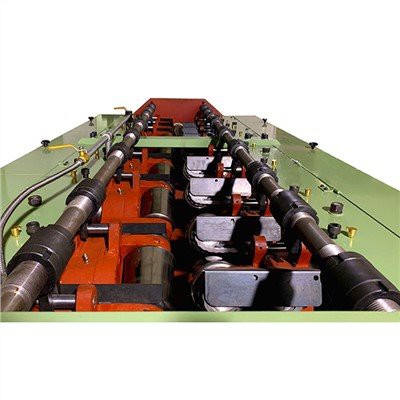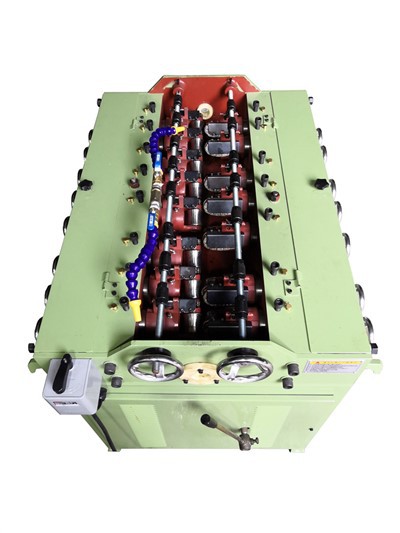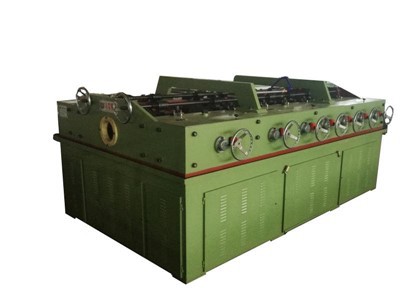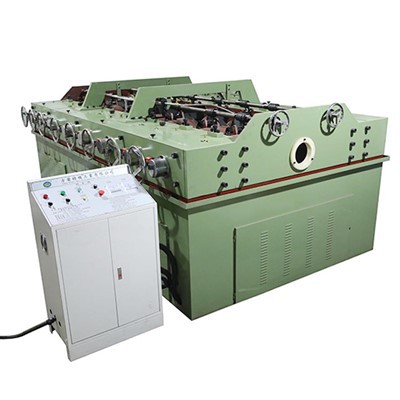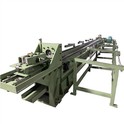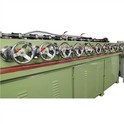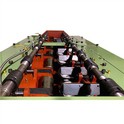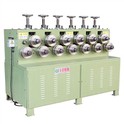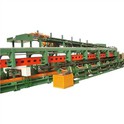Why Choose Us?
Rich Experience
"FANGRONG" brand established in 1998, we are the leader of straightening machine, drawing machine, and pointing machine in China.
Wide Range of Applications
We have rich experiences in aluminum industry, copper industry, stainless steel industry, titanium alloy industry, magnesium alloy industry, molybdenum alloy industry, lead alloy industry, set.
Reliable Product Quality
Our company has been providing customers with better quality products. Our business is always customer-oriented and focuses on creating customer service experience.
Excellent Customer Service
Our goal is to make professional first-class equipment, first-class service and first-class innovation, and realize product specialization, technology specialization, service specialization and teamwork.
What is Straightening Machine?
The straightening machine is one of the most important machines in a metal workshop. It is used to straighten metal, so that it can be used in construction or other applications. The use value of the Straightening Machine is determined by its ability to straighten metal quickly and accurately. The machine is operated by a control panel that has a number of different settings. The user can select the setting that they want, and then the machine will operate accordingly. The settings are usually determined by the thickness of the metal and the type of material that it is made from.
Advantages of Straightening Machine
Accuracy and precision
Using a straightening device assures accuracy and precision in metal components. Straightening devices use advanced technology to identify even minor bends or warps in metal products. They can use this technology to accurately straighten metal products, guaranteeing that they satisfy your specifications and requirements.
Higher quality end-product
Another significant advantage of employing a straightening machine is that it increases the quality of your finished products. Straightening out the metal materials before working with them will allow you to obtain a high level of consistency and quality in your finished goods. This is especially critical in areas like car production and aeronautical engineering, where even little deviations from specifications can have catastrophic implications.
Save time
These machines are also quite efficient, saving you a significant amount of time. They may execute the task swiftly and properly instead of physically straightening out metal materials, which can be a time-consuming operation. This implies you’ll be able to finish projects faster and move on to the next one.
Highly Economical
They might also save you money in the long run. You can avoid costly mistakes by ensuring that your metal supplies are straight and correct from the start. Scrapped materials, poorly completed products, and safety concerns are all examples of this.
Worker safety
Employing straightening equipment in the workplace can increase safety. Metal materials that have been twisted or deformed might be dangerous to workers handling them. You can prevent industrial accidents and injuries by straightening up metal objects before use.
Types of Straightening Machine
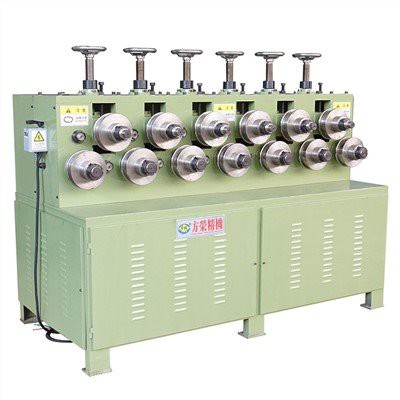
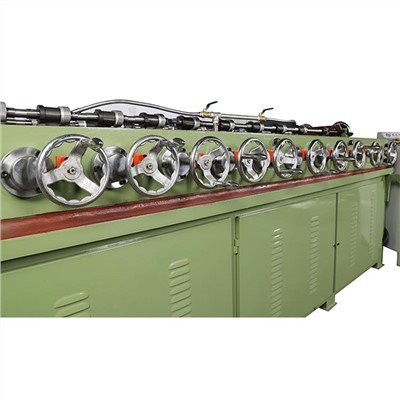
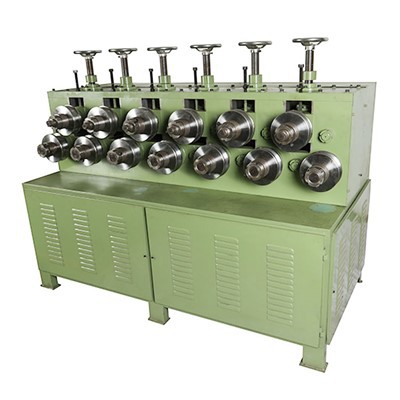

Roller Straightening Machines
Bar and Tube Straighteners: Utilize a series of rollers positioned in specific angles to gradually straighten bars or tubes. These machines can be designed for both round and shaped materials and are effective for materials of various diameters.
Sheet Metal Straighteners: Aimed at flattening sheet metals, these machines feature rollers arranged in two planes. They are essential in industries where sheet metal is used for manufacturing parts, ensuring material flatness and uniformity.
Rotary Straightening Machines
Rotary straighteners are predominantly used for precision straightening of round bars and tubes. They work by bending the material around sets of rollers arranged in a helical pattern, correcting imperfections through rotation and controlled pressure. This method is particularly suited for high-speed straightening of long products.
Press Straightening Machines
These machines use hydraulic or mechanical presses to apply direct pressure at specific points along the material to correct bends and distortions. Press straightening is often used for components with irregular shapes or for materials that require precise localized straightening, such as large metal plates or complex profiles.
Two-roll Straighteners
Two-roll straighteners, also known as "duo" straighteners, employ two opposed rolls to flex the material back and forth, removing curvature through a series of incremental adjustments. This type is particularly effective for thick bars and heavy sections, offering good control over the straightening process.
Multi-roll Straighteners
These machines use multiple rolls, often in a staggered configuration, to straighten materials. The multi-roll approach is effective for both flat and shaped products, providing high precision and the ability to adjust for various degrees of straightness requirements.
Stretch Straightening Machines
Stretch straighteners apply tension to the material until it yields slightly, removing bends and twists. This method is especially useful for materials that are prone to warping during heat treatment or machining. Stretch straightening is commonly used for aerospace components and precision manufacturing where the highest degree of straightness is required.
Heat Straightening Machines
Heat straightening involves applying localized heat to a deformed area of metal, followed by controlled cooling. This process can correct distortions without significantly altering the material's properties. It's commonly used for structural steel components that have warped due to welding or other heat-intensive processes.
Application of Straightening Machine
Construction and Plumbing Industry
The construction and plumbing industry is one of the primary beneficiaries of straightening machines. In construction projects, pipes need to be precisely cut and straightened to fit specific measurements. Whether it's for water supply systems, drainage, or structural components, these machines play a pivotal role in ensuring that pipes meet stringent standards, leading to a more efficient and reliable infrastructure.
Manufacturing of Metal Structures
Industries involved in manufacturing metal structures, such as those producing steel frames for buildings and bridges, heavily rely on straightening machines. These machines contribute to the creation of uniform and accurately sized metal components, enhancing the structural integrity of the final product. The ability to handle various pipe sizes and materials makes these machines versatile in catering to the diverse requirements of metal structure manufacturing.
Automotive Industry
Precision is non-negotiable in the automotive industry, where components must adhere to exact specifications. straightening machines find extensive use in fabricating exhaust systems, chassis components, and other crucial parts of vehicles. The accuracy provided by these machines ensures that automotive manufacturers can maintain high-quality standards while streamlining their production processes.
Shipbuilding
The shipbuilding industry demands meticulous attention to detail to ensure the safety and reliability of marine vessels. straightening machines are instrumental in fabricating pipes used in ship construction. From intricate piping systems to structural components, these machines contribute to the creation of seaworthy vessels with precision-cut and straightened pipes.
Aerospace Sector
In the aerospace sector, where lightweight yet robust materials are crucial, straightening machines play a critical role. These machines assist in the fabrication of components for aircraft and spacecraft, contributing to the overall efficiency and safety of the aerospace industry. The ability to work with various materials, including specialized alloys, makes these machines invaluable in aerospace manufacturing.
Energy and Oil & Gas
Industries involved in energy production and oil & gas exploration benefit significantly from the use of straightening machines. In these sectors, pipes are used for transporting fluids and gases over long distances. The precision offered by these machines ensures the integrity of pipelines, reducing the risk of leaks and enhancing the overall safety and efficiency of energy infrastructure.
Key Components of Straightening Machine
Rerouting Part
It can realize automatic setting-out without hoisting. It should be installed about 6~8 meters away from the front end of rebar straightening machine to ensure that there is enough tension and length margin in the process of steel bar straightening.
Pre-Adjustment Part
It mainly relies on five sets of vertical straightening wheels to finish the stress relief treatment of steel bars supplied from the material rack, so as to achieve derusting on the surface of steel bars. This part is equipped with an incoming guide sleeve device, which generally completes pre-adjustment work of tightening and stress relief.
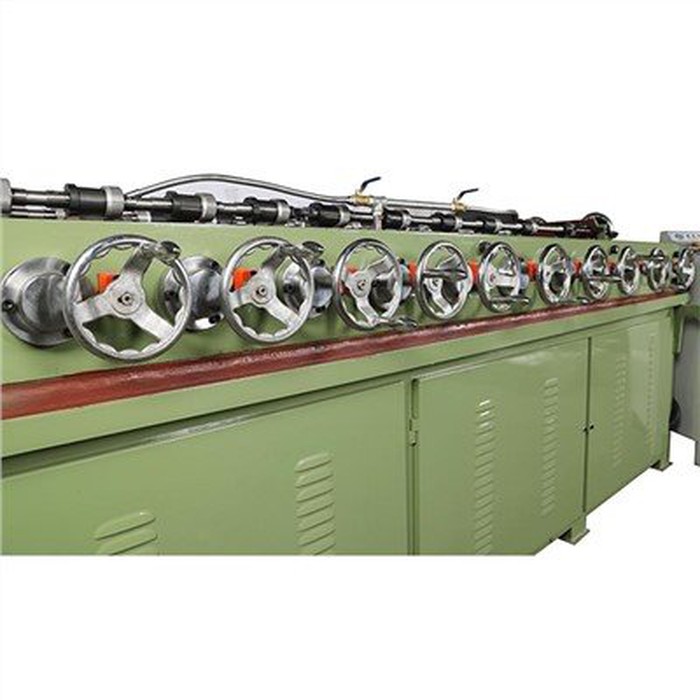
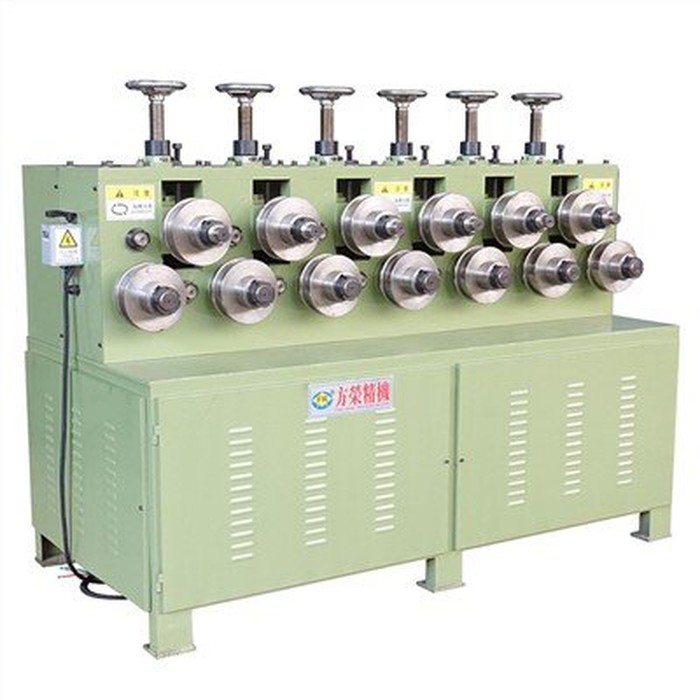
Straightening Barrel Part
It mainly relies on relieving stress to promote the running of steel bars. The straightness of reinforcement can be adjusted at will by using the forward and backward movement of the left and right wires of the straightening wheel bracket.
Traction Feeding Part
It mainly includes one set of active feeding box and one set of passive feeding box. It is assembled behind the turbine shaft of the driving box to drive the sprocket and chain of the driven box, thus driving the driven box behind to complete the whole feeding work before and after straightening.
How Straightening Machine Works?
A straightening machine works by leveraging hydraulic force to effectively straighten a wide range of metal materials, ranging from rods, bars, and tubes, to wires. The process involves clamping the metal material securely in place between two opposing rollers. Then, they put pressure on the material until it is bent in the opposite direction of the original bend, thus straightening it. The hydraulic force can be adjusted based on the thickness and hardness of the metal material to ensure accurate and efficient straightening.
The straightening machine is equipped with advanced sensors that provide real-time feedback during the straightening process, ensuring that the metal material is properly aligned throughout the process. Additionally, the machine is designed to be highly versatile, with the ability to straighten metal materials with varying diameters, lengths, and thicknesses.
Furthermore, straightening machine leverages multiple rollers to provide various arrangements reducing any potential damage on the surface during the straightening process. This results in a high-quality finish that meets the stringent requirements of various industries, such as construction, automotive, and aerospace.
Straightening machine is a highly efficient and versatile piece of equipment that leverages mechanical force and easy-to-use position gauges on each roller to straighten metal materials with incredible accuracy and precision. With its reliable assembly, the machine ensures that the finished product is of the highest quality, meeting the demands of various industries irrespective of their requirements.
How Does Straightening Machine Improve Product Quality?
At the core of the transformation lies the unmatched precision that straightening machines bring to the manufacturing process. These machines are engineered with state-of-the-art technology, ensuring that metal components are flawlessly straightened with minimal deviations. The meticulous calibration and automated adjustments lead to a level of precision that was once considered unattainable through conventional means.
Consistency is the hallmark of superior quality, and straightening machines are delivering just that. Whether dealing with rods, pipes, or sheets, these machines ensure a uniform straightness throughout the production line. This newfound consistency not only enhances the aesthetic appeal of the final products but also contributes to improved functionality and reliability.
In the pursuit of perfection, traditional metalworking often resulted in substantial material waste. Straightening machines have significantly mitigated this issue by minimizing the need for overcorrection and rework. The efficient use of raw materials not only reduces costs but also aligns with sustainable manufacturing practices, a growing concern in today’s industrial landscape.
Human error, albeit unintentional, has long been a challenge in the manufacturing process. Straightening machines have effectively addressed this issue by automating the precision-critical aspects of metal straightening. This not only reduces the likelihood of errors but also allows skilled workers to focus on tasks that require a human touch, further enhancing overall efficiency.
Metal industry is no stranger to stringent quality standards, especially when catering to diverse sectors such as construction, automotive, and infrastructure. Straightening machines play a pivotal role in meeting and surpassing these standards, ensuring that the metal products originating are synonymous with durability, reliability, and excellence.
How To Use A Straightening Machine Safely And Efficiently
Wear Protective Gear
Before operating a straightening machine, ensure that you are wearing the right protective gear. This includes hard hats, safety glasses, gloves, and steel-toe boots. These gears will protect you from falling debris and other hazards that could lead to serious injuries.
Inspect the Machine
Before starting the machine, inspect it thoroughly for any faults or damages. Check the belts, chains, guards, and other essential parts. Ensure that all the safety features are in place, and the emergency stop button is within reach.
Adjust the Machine
Adjust the machine according to the size and type of material to be straightened. Consult the manufacturer's manual or seek advice from experienced operators to help you set up the machine correctly.
Monitor the Machine
While the machine is in operation, stay alert and monitor it for any signs of malfunctions or unusual noises. Make sure that you are not overloading the machine. Overloading the machine can cause it to break down, leading to potential accidents.
Keep a Safe Distance
Maintain a safe distance from the machine while it is in operation. Do not stand too close to it, and never reach inside the machine while it is running. Also, keep the surrounding area clear of extra material and debris.
Turn Off the Machine
After using the machine, turn it off and wait for all moving parts to come to a complete stop before touching it. Remove any remaining material and debris to keep the area clean and free of hazards.
Maintenance Tips for Straightening Machine

Regularly Check the Straightening Machine
One of the best ways to maintain a straightening machine is by regularly inspecting it to identify any potential problems or defects. Check for any signs of wear and tear, such as cracks or dents in the base or frame. Also, inspect the rollers, bearings, gears, and other components that make up the straightening machine. Repair or replace any damaged parts immediately to avoid further damage.
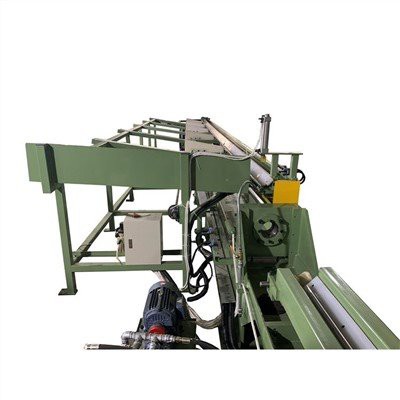
Keep the Machine Clean
A clean straightening machine is less likely to develop mechanical problems. Wipe down the machine with a clean, dry cloth after each use to remove any dust or debris. You can also use a mild cleaning solution to remove any oil or grease buildup on the machine. Ensure that no water or cleaning solution penetrates the bearings, gears, or rollers, as this can cause corrosion or rusting.

Lubricate the Machine
Frequent lubrication of the straightening machine is essential to keep it running smoothly. Use a high-quality lubricant and apply it to the rollers, bearings, gears, and other moving parts of the machine. Avoid over-lubricating as this can cause the machine to attract dust and debris.

Train employees on Proper Use and Maintenance
Ensure that your employees are adequately trained on how to use and maintain the straightening machine correctly. Provide them with the necessary safety equipment, such as gloves, eyewear, and ear protection, to avoid accidents. Also, educate them on how to identify and report any mechanical problems.
The Considerations for Buying Straightening Machine
Material
Various buyers intend to use different methods to uncoil metals into straight parts that can be used in different applications. Generally, roller straightening machines are used on bent metal sheets, flat materials, wires, and pipes. These materials are led over a system of rollers to achieve straight or plane results. Usually, the rollers are made from extremely hard and heavy 52100 heat-treated steel. They are used to straighten metals like zinc, titanium, and aluminum. On the other hand, some machines use the oxy-acetylene flame, which is focused on a selected part of a workpiece. The process removes the deformations from materials like steel, copper, nickel alloys, titanium, and aluminum.
Cost
The cost of metal straighteners is dependent on various factors. Firstly, on average, simple metal straightening machines can cost as low as USD 5,000. As the complexity of the machines increases, they cost way above USD 60,000. The initial purchase depends on the quality and structural parameters of the machinery. An automatic metal straightener with dependable technical aspects and higher performance is more costly than a simple mechanical metal straightener. To acquire the most appropriate metal straightener, buyers are required to take into account the set budget and the demand arising from their production line.
Shape and size
The shapes and sizes of metal straightening machines determine the space required for their storage and the shapes and sizes of the metal parts to be produced. For instance, some industrial metal straightening machines are in sizes of around 150*60*90 cm and can weigh above 400 kg. In that case, buyers need to mind what they intend to produce and the availability of space to accommodate the machines, operators, and materials. Also, the metal parts sizes determine the size of the straightening machine to be purchased. Generally, the technical specifications for straightening sheets include a piece thickness of around 2-23 mm. The width of the material should range from 100 mm to 1,300 mm and have a minimum length of 160 mm.
Required tolerance
With a length tolerance of up to 1 mm and a high straightness of around 2 mm/m, a metal straightening machine could achieve a result with the fewest corrections. Ideally, during a straightening process, the metal part repair reduces the stress in the workpiece fibers that initially caused it to bend. A successful restoration of the deformed material fibers to the original state enhances the durability of the metal part. However, achieving this can be difficult because straightening results in more stress on the metals. As a result, buyers should opt for the most appropriate metal straightening machine based on the metal material, design, and type of bend.
Speed
The speed of metal straightening depends on the capabilities of the machine type and the material properties of the workpiece. This determines the accuracy of the straightened metal parts as well as the amount of material that will be run in a certain period. Averagely, most quality metal straighteners can attain a working speed ranging from 70 m/min to 150 m/min. The speed of a metal straightening machine should meet the demand of the buyers’ production operations.
Voltage
Most industrial metal straightening machines require a voltage of around 200 volts to function well. This ensures fine processing of metal parts with low failure rates. Generally, the maximum thickness and width of workpieces are important in determining the voltage requirement for metal straightening machines. Materials with high yield strengths require greater voltage to achieve the desired level of straightness. Notably, automatic machines can maintain trouble-free operations for a prolonged time under normal conditions and the required voltage.
Our Factory
Dongguan Fangrong Precision Machinery Industry Co., Ltd., established in 1999, is a professional manufacturer of wire drawing machines, straightening machines, wire rolling machines and other equipment. The company is a professional manufacturer integrating development, production and sales, Our goal is to make professional first-class equipment, first-class service and first-class innovation, and realize product specialization, technology specialization, service specialization and teamwork.
Ultimate FAQ Guide to Straightening Machine
We're well-known as one of the leading straightening machine manufacturers and suppliers in China. Please rest assured to buy discount straightening machine for sale here and get quotation from our factory. For customized service, contact us now.
steel straightener machine, steel bar straightening and cutting machine, rotary tube straightener
